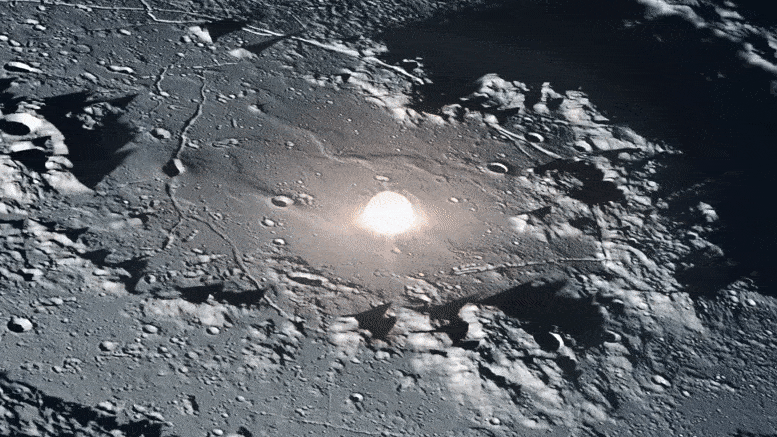
Artist’s animation of a rocket booster crashing into the moon.
Observers have been tracking a chunk of space junk, waiting for it to strike the Moon. It should’ve hit the far side of the Moon, and hopefully, orbiters will have images of the impact site, though that might take a while.
The origins of the junk are in dispute. Some say it’s a spent booster from a Chinese rocket. Others say it’s from a SpaceX rocket. So far, nobody is claiming it.
Bill Gray was the first one to spot the object. Gray writes the Project Pluto software that tracks Near-Earth Objects (NEOs.) Initially, Gray said the object was the second stage from NASA’s DISCOVR spacecraft launched in 2015. That was a SpaceX Falcon 9 upper stage. Then he retracted that after talking with JPL. Now Gray says that it’s a Chang’e 5-T1 rocket booster from 2014. China denies it, which isn’t surprising.
But whatever it is, Gray said on his website, “If this were a rock, I’d be 100% certain. (And I am 100% certain it will hit close to the above point at that time.) But space junk can be a little tricky.”
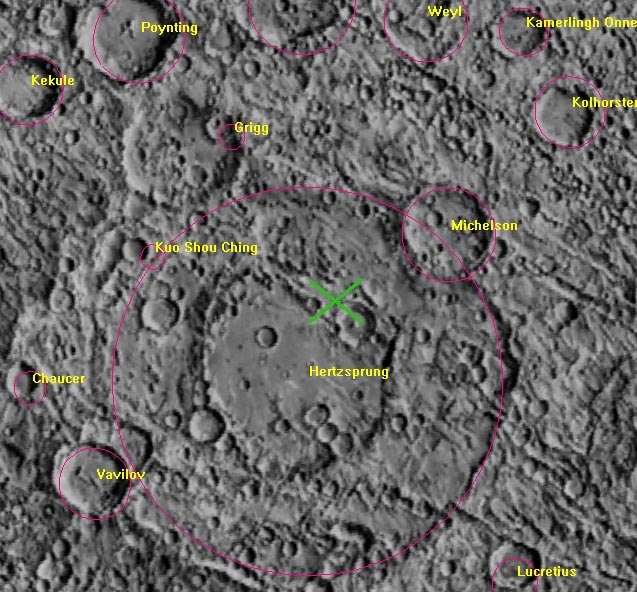
Bill Gray from Project Pluto calculated that the space junk would hit at or near the green x in this image. Hertzsprung crater is an enormous impact crater on the lunar far side, and it’s about 570 km (350 miles) in diameter. Credit: Bill Gray/Project Pluto
The hunk of junk has been traveling through space for seven years and impacted the Moon at about 9,300 kph (5,800 mph.) It should’ve struck the Moon on March 4th, and it should’ve left a crater about 20 meters (65 feet) in diameter. No observers, human or technological, were in a position to watch the impact.
But NASA’s Lunar Reconnaissance Orbiter (LRO) will try to find it. That could take weeks or even months, though.
“NASA’s Lunar Reconnaissance Orbiter will use its cameras to attempt to identify the impact site and determine any potential changes to the lunar environment resulting from this object’s impact,” an agency spokesman told The Wall Street Journal. “The search for the impact crater will be challenging and might take weeks to months.”
NASA’s LRO carries a suite of scientific instruments, including a camera system called the Lunar Reconnaissance Orbiter Camera (LROC). LROC captures high-resolution images of the lunar surface. It’s spotted equipment left behind by the Apollo missions, so it should be able to find the impact site and what’s left of the space junk. (Moon junk?)
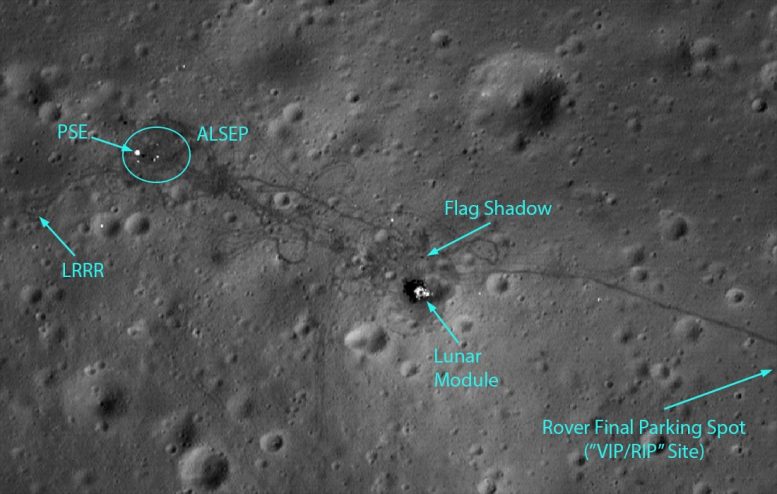
The Lunar Reconnaissance Orbiter captured images of the Apollo 15 landing site, including some of the debris left behind. Hopefully, it’ll have no problem finding the space junk impact site from March 2022. PSE is the Passive Seismometer Experiment. LRRR is the Lunar Ranging Retroreflector. They were both parts of the Apollo Lunar Surface Experiments Package (ALSEP.) Credit: NASA/ASU/LRO
This is more than just a tale of a wayward piece of space debris with unacknowledged origins; there’s some science involved.
There’s a lot that scientists don’t know about impact craters. Impact craters are everywhere, and they’ve been imaged and studied in depth. But this is a chance to see a newly-formed crater. And in this case, we know the mass of the impactor, and we know its velocity. Scientists can also tell the object’s orientation at the time of impact from the crater shape and the ejecta. The impact will also reveal data about the impact site itself.
Paul Hayne is Assistant Professor of Astrophysical and Planetary Sciences at the University of Colorado, Boulder. He’s the author and co-author of many papers on the Moon and other planetary science topics. He wrote an article at “The Conversation” about the impact called “A rocket crashes into the Moon – the accidental experiment will shed light on the physics of impacts in space.”
“Without knowing the specifics of what created a crater, there is only so much scientists can learn by studying one,” Hayne writes. “As a planetary scientist who studies the Moon, I view this unplanned impact as an exciting opportunity.”
Usually, when a human-made object strikes a Solar System body, it’s by design. So this impact is like an unplanned experiment. What can researchers learn?
When we look at planets like Mercury and Earth’s Moon, we see surfaces that have been battered by impacts for billions of years. There are a lot of scientists still don’t know about the impact process and the physics behind it. “A deeper understanding of impact physics will go a long way in helping researchers interpret the barren landscape of the Moon and also the effects impacts have on Earth and other planets,” Hayne writes.
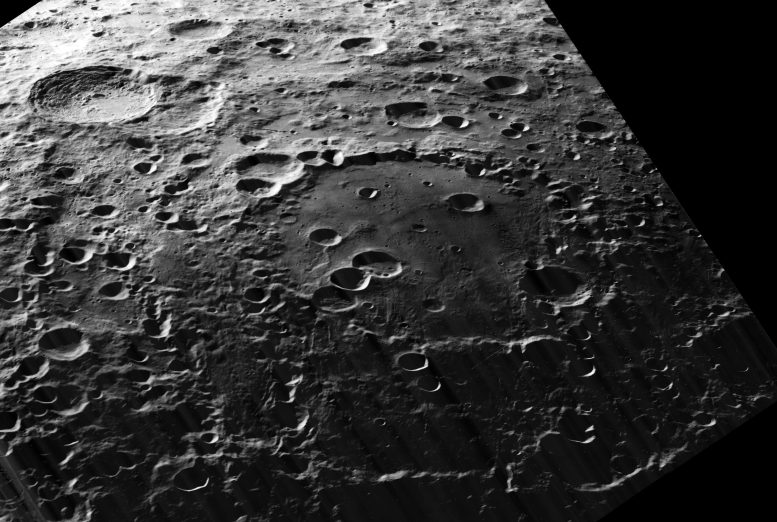
This is an image of the Hertzsprung crater from Lunar Orbiter 5. Credit: NASA/Lunar and Planetary Institute
We don’t know whose rocket stage it is, but we know the approximate size and mass. It’s about 12 meters (40 ft) long and weighs about 4,500 kg (10,000 lbs.) When the object strikes the Moon, a shockwave will travel the object’s length, and the back end will be destroyed, sending metal debris in all directions. We know this because of NASA’s Lunar Crater Observation and Sensing Satellite (LCROSS) mission.
NASA launched LCROSS at the same time as the LRO. Its mission was to determine the nature of the hydrogen that India’s Chandrayaan-1 probed sensed at the Moon’s polar regions. LCROSS successfully detected water, but it did something else important, too. It collected and relayed data from the spent Centaur upper stage as it crashed into the Moon on October 9th, 2009.
Scientists also performed impact experiments at the NASA Ames Vertical Gun Range designed to recreate the impact and study it further. They were able to explore the impact plume and the ejecta and to determine how much volatiles can be released by such an impact. The combined effort shed light on how impacts could’ve delivered liquid water and other materials.
“By studying the composition of the dust plume lofted into the sunlight, scientists were able to find signs of a few hundred pounds of water ice that had been liberated from the Moon’s surface by the impact. This was a crucial piece of evidence to support the idea that for billions of years, comets have been delivering water and organic compounds to the Moon when they crash on its surface,” Haynes writes.
Steady impacts over billions of years have shaped the Moon’s surface, creating a layer of loose, pulverized rock that covers most airless worlds. This process is widespread but not well understood. “However, the overall physics of this process is poorly understood despite how common it is,” Hayne writes.
Unfortunately, the LCROSS crater is hidden in perpetual shadows and has resisted further study.
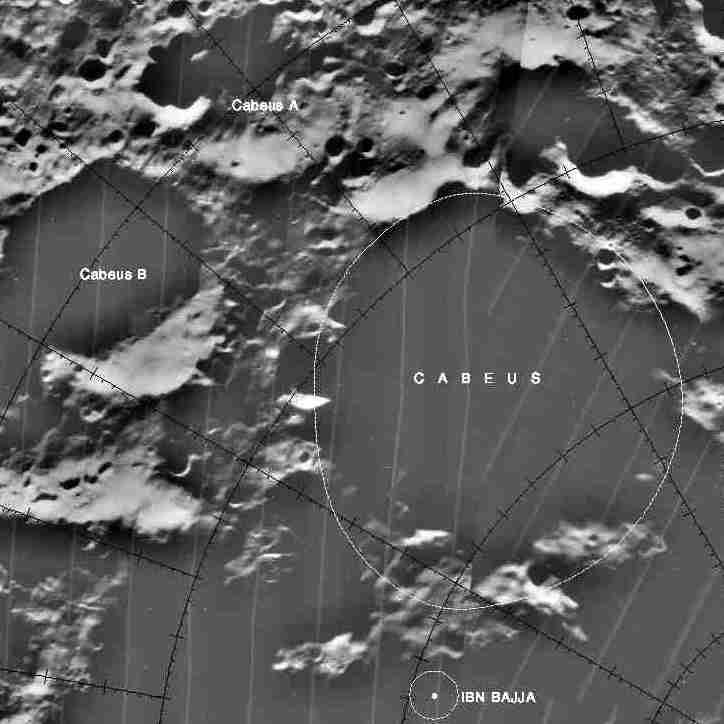
LCROSS crashed into the Cabeus crater, only 100 km (62 miles) from the lunar south pole. At that location, the impact crater is in almost perpetual shadow. Credit: USGS
But this time, it’s different. Though this impact is unintentional, it’s another opportunity to learn more about the Moon, impacts, and the transportation of water and other materials around the Solar System. We just have to wait for the LRO to get in a position where its powerful cameras can get to work.
Scientists will then have access to before and after images of the impact site, and they’ll be able to identify changes in the surface, which can extend for hundreds of meters.
This impact and its lessons are essential when we look to the future. There are a bunch of missions to the Moon planned by multiple agencies, even private companies. The more we learn now, the better prepared these missions will be.
As for Bill Gray, the man who first spotted the rocket debris, he maintains that it’s a Chinese booster. Gray pointed out that there are some quirks in the object’s path. On his website, he says, “I’d have expected the perigee to be near the earth’s surface. The perigee seemed quite high.” He attributed that to fuel that remained in the booster after separation. “However, rocket hardware often does strange things in its early days in space, with leftover fuel leaking out and pushing it around. That causes changes in the orbit so that when you try to figure out where the junk came from, you get a wrong (or at least altered) answer.”
Haynes doesn’t seem as concerned with the object’s origins as Gray is, and he sees it as inadvertent, though welcome, science. “Regardless of this wayward rocket’s identity, this rare impact event will provide new insights that may prove critical to the success of future missions to the Moon and beyond,” Haynes writes.
When it comes to the object itself, we may never know who sent it into space. But that doesn’t matter. The party responsible might not want to admit it’s their rocket, but they’re the unwitting funders of a serendipitous science experiment that might’ve cost millions to perform on purpose.
Adapted from an article originally published on Universe Today.



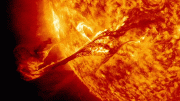
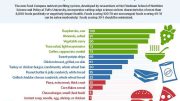



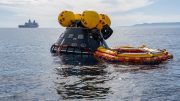
Someone should tell the artist that you can’t have a fiery Michael Bay explosion without OXYGEN.
They should also tell the artist that a tumbling rocket in space does not randomly move to different positions. It rotates with constant angular momentum. I understand that a spinning wing-nut can appear to randomly achieve different orientations (see YouTube videos of demos in space). However, such scenarios would require special effort to setup the rotatoin.
Shoulda, coulda, woulda, nothing but speculation here and no facts.Basically a click bait article
Just like Wuhan, our “science” is more fearful of the Chinese than they are the impact on the moon…
Explosion……….um………no,shadow…….um………….yes……but missing.
Good artist that.
What a terrible animation.
Hey kids, there would be no ignition of anything on the surface because there is no oxygen.
Furthermore the cloudy roll of debris pictured in your video is what happens on earth when ejected material encounters an atmosphere to slow it down. … something the moon lacks, remember?
Any quick scan of the web can retrieve a number of images of collisions in space. For an ostensibly scientific publication you might advise your illustrator to use them as reference points. And what was your editor doing when this illustration was being proposed for the article?
Jack, that’s just from the heat of the impact itself. A heavy object moving fast has a lot of kinetic energy that needs to go somewhere if it suddenly comes to rest. That energy turns into heat, including the bright flash: hot metals vaporize but also glow white-hot.
All these geniuses here calling the animation out for showing an explosion fail to realize that rocket stages contain oxidizers (in this case, literally liquid oxygen) so there absolutely could be an explosion from a crashing second stage considering that it very likely would have fuel and oxidizer left over.
Even if the junk does still contain explosive/flammable material, that explosion does not look natural for the conditions of the crash.
Just like Joe Biden….Crash and burn
Just like a Herded Trumpkin, trying to make it political…..
I am surprised Trumpers can even read this article, normally this kind of stuff goes way above their puny heads.
Hello? Moon doesn’t have atmosphere! That thing should be floating not falling down full speed 😂😂😂 what is this supposed to be, a guilt trip? A warning from the aliens?
The object is headed into the moon. Why would it “float”? If you shoot a rocket directly at the moon, what do YOU think it’s pre-impact trajectory will look like?
Family Guy is far better than this kids…
BASIC CAUSE AND EFFECT 101
The MOON’s Center of Gravity (COG) …IS ON THE EARTH… ( just below the surface of the earth …RIGHT BELOW OUR FEET about 1050 miles.
Consequently ..any Mass Weight added to the Moon alters that COG BRINGING IT UP CLOSER TO THE SURFACE and pulls down the weight of the Atmosphere (= LOW BAROMETRIC pressure), with the increased gravity facilitating any extra agitation on the crust and different earth plates.
Two-ton Meteors (ir-)regularly strike the moon (at 3000 mph) ..sometimes as Meteor Storms…and are the mass weight which is over-sufficient to alter the COG…proportionately.
I matched every MAJOR meteor impact on the moon between 1969 and 1977 ….with every MAJOR cataclysm on the earth ..in a semi “double-blind” test…whereby each impact corresponded exactly.
Thus it is not an accident that during the same timeline period of meteor impacts, the phenomena of both MAJOR earthquakes and hurricanes (or tornadoes) will occur SIMULTANEOUSLY. This is especially visible when EVERY YEAR ..both the Leonid and Perseid meteor showers engage their activity with the Earth’s trajectory. Now with this most intense impact … everyon can witness what I discovered back in 1969. The cataclysyms have already started and should continue for at least four days in different locations. Depending on the coordinates and time of impact… certain places which are ripe for the gravity impetus to act as a catalyst…will be displayed as unquestionable evidence.
But after that hit some https://www.youtube.com/watch?v=eOfd4ganfsU&t=28s
For what you are discussing, you are confusing the Moon’s Center of Mass with the Earth-Moon CM (bathycenter). As for your study, if it was worth the electrons you just jiggled writing that paragraph, it would be publishable. Submit it for review or don’t mention it.
moonloo what on ‘earth’, pun intended, are you rambling on about. The centre of gravity of the moon is at roughly at the centre of the moon…
Wait! Human junk making a Far Side impact? This sounds like a great opportunity for a Gary Larson cartoon. 🙂
It’s sad that we’re making the moon a scrap yard just like we’ve done here on our planet. Mars is just as bad. I know we have to explore other planets. But we need to have a plan of cleaning up the junk that we leave.
Typical scientists. They all want credit and argue so they seem right. Einstein once stated, everyone thinks they are a genius, but if you saw a fish climb up in a tree, you would think that was the dumbest thing you ever saw.
Anyone notice how they had to slip into the article that the observer satellite that orbits the moon was able to find what was left behind by one of the Apolo missions? That was a rather convenient way of making it seem like it is common knowledge that Nasa went to the moon, by I’m not so sure they did. There is a great deal of compelling evidence to suggest that Nasa never did go to the moon. I’m wondering how everyone here feels about this issue – the possibility that Nasa lied about putting men on the moon. One interesting tid bit on this topic:. When asked why Nasa never returned to the moon a spokes person for Nasa said, “We had that technology but it was lost” – I’m not making this up.
Im curious to know the sound it made when that junk hit the moon and how deep the impact hole was.
Off topic: In the early 1980s the US went through a “GAS SHORTAGE”… At that time we used a commodity called “GASAHOL”! IT WORKS AND ITS CHEAP ! ! ! WHY CANT WE DO THAT AGAIN ???
I am curious how NASA claims to know that this particular piece of space debris is 40ft long..weighs 10,000 pounds..was traveling around 3500 thousand miles per hour when it hit the moon and supposedly NASA has also been keeping track of it now for the 7 years it has just been floating around in orbit.. These are all supposed facts that Nasa claims to know.. Well to me that is a large amount of data to know about an object in space but then in NASA’s same article when asked the origin of the object whether it’s American space debris or China’s debris the NASA scientist seem to be confused and unsure who is to blame for the debris and even go as far to say that it must be from China..so quick to blame someone else without any evidence to support.. I said all that to say this.. How can our country claim to know every single detail concerning this piece of space debris from the size to the weight and speed traveling.. following it for 7 years all the way to be able to pin point the exact moment it was to strike the moon and where but then have the audacity to say to the world we know all this but not if it was from our rockets or China’s.. and then try to blame China.. It furiates me when my country says things like that out loud in the media and then just presume that the we as the common people of this country are so stupid or uneducated that we simply believe everything they tell us without question..We are not a nation of stupid easily influenced people who just believe anything we are told and say it must be true cause I saw it on TV.. I’M tired of my government continuing time after time basically treating and telling us things that if we were to believe makes us look and sound so stupid as common people.. We are not a stupid nation of people and we need to start standing up to our government for treating us as ignorant people without a voice and constantly telling us lies on the news or in the media daily.. Stand up and let your voice be heard.. Start demanding the truth from our government.. One person can’t make a change but united we can change the world
By the time we are able to move from earth to another planet we’re not gonna be able to cause all the space junk floating around up in the atmosphere around our planet so forget about an asteroid hitting us cause we already damned our selves from the space junk floating around our planet so it was nice knowing all of you
They should be stopped, we’ve already destroyed this planet now these idiots are dumping junk in space, and it can’t be any good for the ozone layer sending rockets through it. All in the name of science